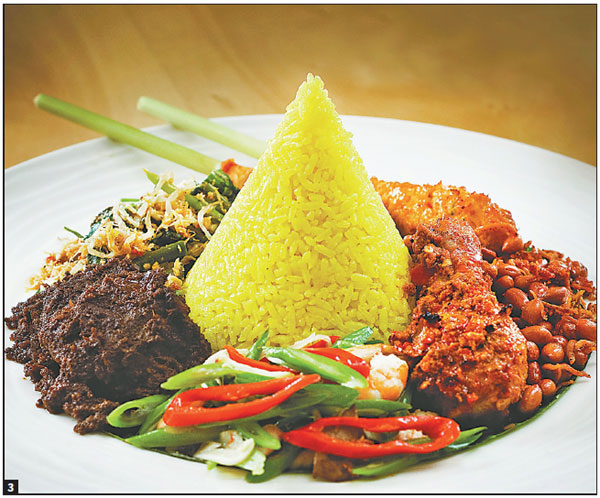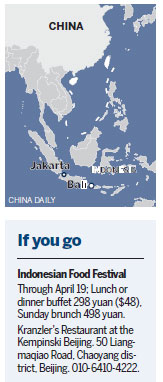Spicy encounter
Updated: 2015-04-16 08:03
By Mike Peters(China Daily)
|
|||||||||
Sweet. Salty. Hot as fire. Whatever your taste, Indonesia's cuisine offers an array of flavors to explore. Mike Peters chows down for a savory buffet.
Often when a country observes a big political anniversary, the focus is heavy with speeches and deal signings and other formalities. Indonesia, a land of more than 13,000 islands and 300-plus ethnic cultures, is marking its 65th anniversary of diplomatic relations with China by feasting for several days in Beijing.
Diverse geography and centuries of sea trading have produced a world of good eating, says Indonesian chef Budiyana Ramelan, who leads a team of chefs from the Kempinski Jakarta that's cooking up the ongoing Indonesia Food Festival in China's capital. "It's not all hot spicy," he says. "In Java, much of our food is sweet. In Sumatra, it's famously hot. Other Indonesian dishes are salty, or some combination with different layers of taste.
Beef rendang, for example, builds flavor from what seems like an entire spice cabinet. There is ginger, galangal, lime leaf, turmeric, cumin, cinnamon, cloves, star anise and more in what is probably the nation's most famous dish.
"It needs to simmer for seven hours," insists the man known as "Chef Budi". Then, he says, put it in the refrigerator and reheat to serve the next day. "That's the way to bring out all of the flavor."
There is no authoritative account of rendang's origins, but documents from 3 centuries ago show that haj pilgrims from Minangkabau carried rendang among the provisions for their long trip to Mecca. Rendang lasts for a long time, according to the Wonderful Indonesia cookbook produced by the country's tourism ministry, because slow braising "perfectly caramelizes" the meat.
Other must tries on the menu, he says, are oxtail soup known as rawon Surabaya, made with black nuts he brought from Jakarta in paste form, and opor kuning, a spicy chicken soup redolent with coconut, lemongrass and tamarind.
Arabic influences abound in the cuisine of the world's most populous Muslim country, especially in Sumatra - a hub of the ancient maritime spice trade - and Aceh, where the strongest Arabian legacy colors the culture today. In other areas, Budi notes, Buddhism has influenced the food: Indian traders first came to Bali around 200 BC. The Indonesian islands known as the Moluccas were dubbed "the Spice Islands" by European traders hundreds of years ago.
There is rijsttafel from the Dutch era as well as many contributions from Chinese, the country's largest ethnic group, including noodles, meat and fish balls, and spring rolls.
"Despite differences there is oneness" has become the motto of Indonesia, and it resonates from the broad social fabric to the family dinner table.
"The taste of Indonesia is everyone's taste," says Soegeng Rahardjo, the country's recently arrived ambassador to China. He notes that CNN recently ranked three Indonesian dishes among the top 15 after polling its audience in its World's 50 Best Foods survey. That list had beef rendang in the top spot and Indonesia's version of fried rice, nasi goreng, at No 2.
"Indonesia is a land of diversity," he adds. "From one island to another, the people's tastes are different, like the colors of the rainbow."
Chef Budi literally sees that color on the plates he creates with his fellow guest chefs at the festival, Sri Haryatun and Sugeng Prayitno, and celebrity guest chef and TV cooking show host Farah Quinn.
"Indonesian food is set apart by lots of different herbs, but they are chiefly employed in three blends or bases," Budi says. The yellow base is dominated by garlic, kanda nut and turmeric; the white base drops the turmeric; the red base adds spicy red chili paste.
Beef randang, sambas and skewers of beef and chicken satay have become familiar a round the world, but a festival like this one offers Beijingers a chance to color their palates with an amazing array of flavors.
Contact the writer at michaelpeters@chinadaily.com.cn


|
1. Snacks and carved fruits at the food festival buffet. 2. Celebrity TV chef Farah Quinn (left) gives a demonstration. 3. Tumpeng is an Indonesian way of presenting rice in a cone shape, surrounded by side dishes. 4. Nasi goreng (fried rice) topped with egg. 5. A sampling from the Kempinski buffet. Photos Provided To China Daily |


(China Daily USA 04/16/2015 page07)

 HK singer-actress Mok takes fans on global journey
HK singer-actress Mok takes fans on global journey
 Sandstorm engulfs North China
Sandstorm engulfs North China
 Qinghai quake: Reliving the memory
Qinghai quake: Reliving the memory
 Father horses around to save his son
Father horses around to save his son
 Ten photos you don't wanna miss - April 15
Ten photos you don't wanna miss - April 15
 Oil paper umbrellas made in Sichuan
Oil paper umbrellas made in Sichuan
 Ex-student sought in shooting death of North Carolina college
Ex-student sought in shooting death of North Carolina college
 Women in politics - Hillary Clinton is just one of them
Women in politics - Hillary Clinton is just one of them
Most Viewed
Editor's Picks

|

|

|

|

|

|
Today's Top News
Japan tops China as top holder of US debt
Paulson: US should have joined AIIB
Economic reforms in China are 'needed'
Li Na named Laureus exceptional award winner
Alibaba may face 'blacklist' trouble in US as fakes continue to abound
US to help smart cities
Clinton's win not guaranteed despite global celebrity
US has record number of applications for H-1B tech visas
US Weekly

|

|








